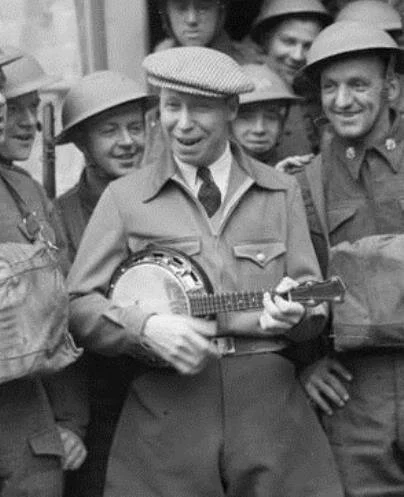Also known as the banjulele, this resonant cross between the banjo and ukelele was first build in 1917 and became especially popular in the 1920s and 30s. Created first by John A. Bolander and by Alvin D. Keech in the US, where most are still manufactured, it combines the small wooden fretted Hawaiian instrument with that of the louder banjo, its volume and sound enhanced by that distinctive round, metal encased skin drum resonator. Most commonly tuned to C, across G–C–E–A, some also have the shriller D tuning (A–D–F♯–B). These interval combinations (fifth, tonic, major third, major sixth) are commonly known as the "my dog has fleas" tuning.
Banjolele assortment
In America, two of the best known players were Wendell Hall and Roy Fleck. The latter (1900-1994) was a vaudeville star who also appeared in many films and known as the Wizard of The Strings, he was admired for his considerable skill not only the the banjolele and ukelele but also guitar and ability to play the 8-string lap steel guitar. He's a compilation of him in action:
In the UK, another notable player was Billy "Uke" Scott, but all other players were overshadowed by the enormous success of the toothily grinning George Formby from Wigan, Lancashire. From a humble career of playing pubs and seaside and local clubs, as a vaudeville comic musician he became hugely successful. Appearing in dozens of films as the cheeky loveable accident prone working-class hero, he was regarded as national treasure during the 1930s and 40s, particularly as a cheery figure of morale-boosting entertainment during the Second World War. Despite his innocent persona of gentle comedy, he was a very ruthless and focused operator.
George Formby entertains troops in 1940
Most of his songs used a simple strumming pattern during the verse and chorus sections, notably When I'm Cleaning Windows, and a signature faster strumming solo towards the end. Here's an example during a later appearance on the BBC:
The banjolele remained in the collections of of many musicians far more famous for playing the guitar. During his post-Beatles career George Harrison played one no his song Any Road.
During a period of heavier rock, Queen's Brian May pulled out the instrument for part of his old-school pastiche Bring Back That Leroy Brown from the band's third album Sheer Heart Attack. In this clip from the mid-seventies, the instrument is quickly whipped out during this live performance.
Finally, as an example from the present, chap-hop creator and purveyor Mr B The Gentleman Rhymer, who in another guise is rapper form the hip-hop band Collapsed Lung, creates a brilliantly charming revival of the instrument in the context of posh English comedy reinterpretation of American rap, adding solos, for example, in his Chap-Hop History:
So then, care to strum up more memories of this instrument? Feel free to share any examples in songs, instrumentals, on albums, film, art or other contexts in comments below.
You can also get in touch the contact page, and also visit us on social media: Song Bar Twitter, Song Bar Facebook. Song Bar YouTube. and Song Bar Instagram. Please subscribe, follow and share. New to comment? It is quick and easy. You just need to login to Disqus once. All is explained in About/FAQs ...



